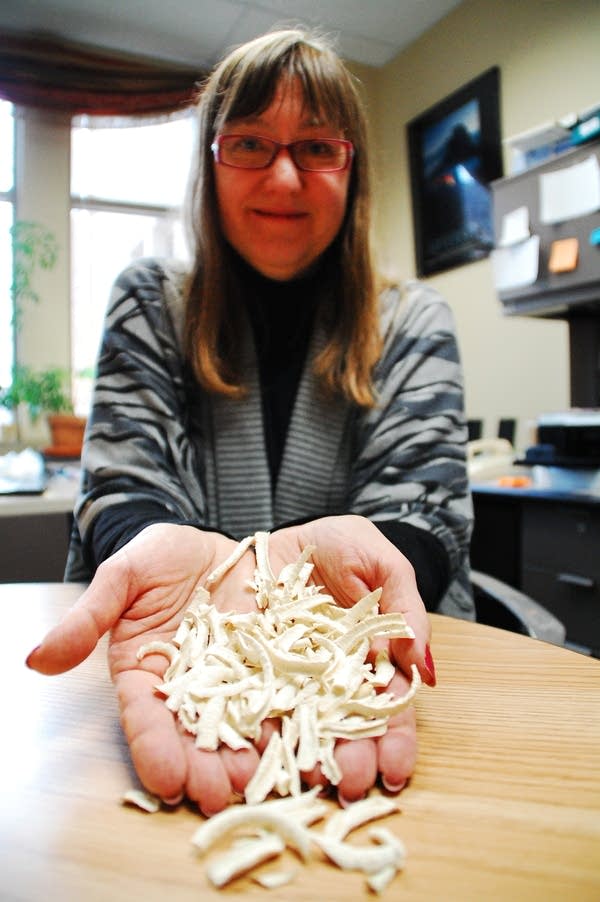Non-profit takes on breadfruit challenge to fight hunger in developing areas
Go Deeper.
Create an account or log in to save stories.
Like this?
Thanks for liking this story! We have added it to a list of your favorite stories.

Breadfruit may sound like a dessert grandma used to make, but it's actually a fruit that grows on tropical islands.
You won't find breadfruit at your local grocery store, mainly because it has an extremely short shelf life.
But a Minnesota-based non-profit group wants to help people in developing countries turn the fruit into flour. The group has asked the University of St. Thomas in St. Paul for help, and in turn the school is sponsoring a contest to gather ideas on how to dry the fruit to prepare it for milling.
"Within 48 hours of becoming ripe it rots," said Bert Rivers, vice president of operations for St. Paul-based Compatible Technology International. The group develops simple hand-powered devices to harvest and process crops in developing countries.
Turn Up Your Support
MPR News helps you turn down the noise and build shared understanding. Turn up your support for this public resource and keep trusted journalism accessible to all.
Right now the group is working on a way to shred breadfruit, dry it and grind it into flour.
Cooked breadfruit has a bland flavor, with a taste ranging somewhere between potatoes and bread. Breadfruit flour has an almost an unlimited shelf life. Some food experts think it could help developing nations fight hunger.
Volunteer engineers working in CTI's workshop in St. Paul have invented and built a breadfruit shredder. It's essentially a manual food processor.

"The shreds then come through the blade, just like it would on your Cuisinart at home," Rivers said. "And then fall down and the parts will be collected below."
The group also has made a hand-cranked device used to grind the dried breadfruit.
"This is going to be a little bit noisy. But you can see how the product comes out as a fairly fine powder," Rivers said.
But there's a step missing between shredding breadfruit and grinding it, Rivers said. The group has yet to devise a good way to dry the breadfruit.
"It's absolutely key," he said. "Without a dried product that can be ground, we don't have a process."
The challenge to creating a breadfruit dryer is that it must be light, inexpensive, easy to use, able to protect the fruit from rain and humidity — and not use electricity or fossil fuels.
CTI has asked the University of St. Thomas in St. Paul to help solve the challenge.
Camille George, an associate professor of engineering at St. Thomas who also sits on the board of CTI, has experimented with drying breadfruit and grinding it into flour.

In her office, George flops a freezer bag full of dusty white breadfruit flour onto a table. It's the result of a recent research trip to Puerto Rico.
"What do you think? Is it beautiful or what?" she says.
"It has a little bit of a greener smell than a wheat flour."
George has had some success in designing her own breadfruit dryer, but she's looking for more ideas.
She's started a breadfruit dryer design contest, and is encouraging teams of other engineers to design and build their own dryers.
The first and second place teams will be flown to Hawaii in March to demonstrate their inventions to the Breadfruit Institute, a group that's promoting the underutilized staple crop as a way to fight hunger.
John Albers, a senior engineering student at St. Thomas, is taking part in the contest. The 22-year old from Shoreview is working with a team of students to design a rack with several shelves used to air dry the fruit.
"It's got to be modular," Albers said. "It needs to be easily transportable. It has to have enough shelf space to dry the fruit. It has to be lightweight. It also needs be stored in a relatively small space."
Albers says it's been rewarding to work on the design. And he hopes at least parts of it are incorporated in the final solution to the breadfruit drying challenge.
There's already interest in tropical regions for what comes out of the contest, George said.
"People from various islands have contacted us saying 'When you get this thing working, we want to know about it'."
George hopes someday that people are able to harvest breadfruit, dry it in the field and take it to a central location in a village or town to be milled into flour.
The next step is finding out how best to use the flour. Bakers are currently experimenting with recipes that include flour made from breadfruit, George said.
Teams interested in submitting designs for the University of St. Thomas' contest should email Prof. Camille George at cmgeorge@stthomas.edu. Teams must submit their designs for dryers by Feb. 15.
Dear reader,
Political debates with family or friends can get heated. But what if there was a way to handle them better?
You can learn how to have civil political conversations with our new e-book!
Download our free e-book, Talking Sense: Have Hard Political Conversations, Better, and learn how to talk without the tension.





